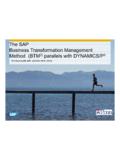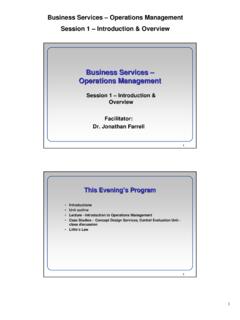Transcription of Organizing for successful change management - …
1 A McKinsey Quarterly online survey sheds new light on what drives a successful transformation in organizational appear to produce the best results when executives mobilize organizational energy and communicate their objectives in a clear, comprehensive, and engaging change mechanisms also were correlated with executives satisfaction with survey, which covered a range of contexts from turnarounds to restructuring, highlights the mixed emotions felt by those on the receiving end of deep-rooted for successful change management : A McKinsey Global SurveyJohn Krause The most successful transformations of business performance occur when executives mobilize and sustain energy within their organizations and communicate their objectives clearly and creatively, according to a new online survey conducted by The McKinsey Executives further improve their chances for success if they significantly raise employee expectations, actively change people s behavior, and engage the attention of individuals at all levels of the organization, from top management to the front line.
2 These and other insights into the change - management process emerge from the survey, in which executives were invited to assess and characterize one transformation they had been involved in during the previous five years. For this purpose, we defined a transformation as a coordinated program, in companies or business units, that typically involves fundamental changes to the organization s strategy, structures, operating systems, capabilities, and The McKinsey Quarterly conducted the survey in June 2006 and received 1,536 responses from a worldwide representative sample of executives at publicly and privately held businesses across a full range of industries.
3 As well as nonprofit and governmental say energy and communication are essential for a successful business for successful change management : A McKinsey Global Survey Why change ?Transformations come in various shapes. Cost cutting, not surprisingly, is a consistent theme, with more than half of the respondents agreeing that it was a major goal. Half say their company s main objective was moving from good performance to great performance, with 41 percent observing that their company s transformation was the result of a restructuring: merging, splitting up, or divesting a part of the organization.
4 Only 27 percent of the executives were involved with turning around a crisis situation perhaps the best-known and most headline-grabbing context for change (Exhibit 1).Exhibit 1 Transformational goalsSource: June 2006 McKinsey Quarterly global survey of business executives% of respondents who have experienced a performance transformation in past 5 years1 What were the main goals of your company s effort at performance transformation?1 All data weighted by GDP of constituent countries to adjust for differences in response rates from various regions; figures do not sum to 100%, because respondents could select multiple answers.
5 Respondents who answered don t know are not only or PA 2006PT SurveyExhibit 1 of 6 Glance: This article's exhibits display respondents' views on what drives a successful transformation in organizational costs50 Moving from good performance to great performance27 Completing or integrating a merger27 Turning around a crisis situation25 Catching up to rival companies14 Splitting up or divesting part of the organization6 Preparing for privatization or market liberalization4 None of the aboveTransformation goals Success is the normWe asked executives to judge the success of the transformation in two ways.
6 One was to gauge the company s subsequent performance, such as its profitability, return on capital employed, market value, and the like. The other was to measure the extent to which the process laid a foundation for sustaining corporate health over the longer term through, for example, upgraded capabilities, closer relationships with customers or suppliers, and a positive shift in organizational culture. Respondents are a little more positive about the first yardstick, with 38 percent saying that the transformation was completely or mostly successful at improving performance, compared with 30 percent similarly satisfied that it improved their organization s health.
7 Around a third declare that their organizations were somewhat successful on both counts. About one in ten admit to having been involved in a transformation that was completely or mostly unsuccessful (Exhibit 2). Exhibit 2 Evaluating performance and healthSource: June 2006 McKinsey Quarterly global survey of business executives% of respondents who have experienced a performance transformation in past 5 years11 All data weighted by GDP of constituent countries to adjust for differences in response rates from various regions; excludes respondents who answered don t know.
8 Figures may not sum to 100%, because of As measured by, eg, profitability, return on capital employed, market value, lead-time reduction, inventory With, eg, upgraded capabilities, closer relationships with customers or suppliers, preventive maintenance, or a positive shift in organizational only or PA 2006PT SurveyExhibit 2 of 6 How successful was the transformation at equipping the organization for sustained, long-term performance?332737101292 How successful was the transfor-mation at improving your organization s performance?26 Completely successful32 Mostly successful33 Somewhat successful7 Neither successful nor unsuccessful11 Somewhat unsuccessful9 Mostly unsuccessful2 Completely unsuccessfulEvaluating performance and health Transformation takes energyWhen we compare the subsequent responses of the 38 percent who characterize their company s transformation as completely or mostly successful (that is, those who are the top performers) with the entire sample, a striking observation comes to light.
9 Whereas around 30 percent of all surveyed executives involved in a transformation say that their organization was completely or mostly successful at mobilizing energy, this number jumps to more than 55 percent when the responses of only the top performers are included. With regard to sustaining that energy, 57 percent of top performers, compared with 28 percent overall, say that their organization was completely or mostly successful . The contrast between top and bottom performers is even greater (Exhibit 3). Exhibit 3 Evaluating organizational energySource: June 2006 McKinsey Quarterly global survey of business executives% of respondents who have experienced a performance transformation in past 5 years1 How successful was your organization in sustaining organizational energy during the transformation?
10 1 All data weighted by GDP of constituent countries to adjust for differences in response rates from various regions; exclueds respondents who answered don t know ; figures may not sum to 100%, because of successful includes respondents who reported transformation was completely/mostly successful ; unsuccessful includes respondents who answered mostly/completely unsuccessful. Web only or PA 2006PT SurveyExhibit 3 of 6 Web only or PA 2006PT SurveyExhibit 3 of 6535212291466615238011 Completely successfulMostly successfulSomewhat successfulNeither successful nor unsuccessfulSomewhat unsuccessfulMostly unsuccessfulCompletely unsuccessfulEvaluating organizational energySuccessful2 Unsuccessful2 Respondents who report transformation was.







